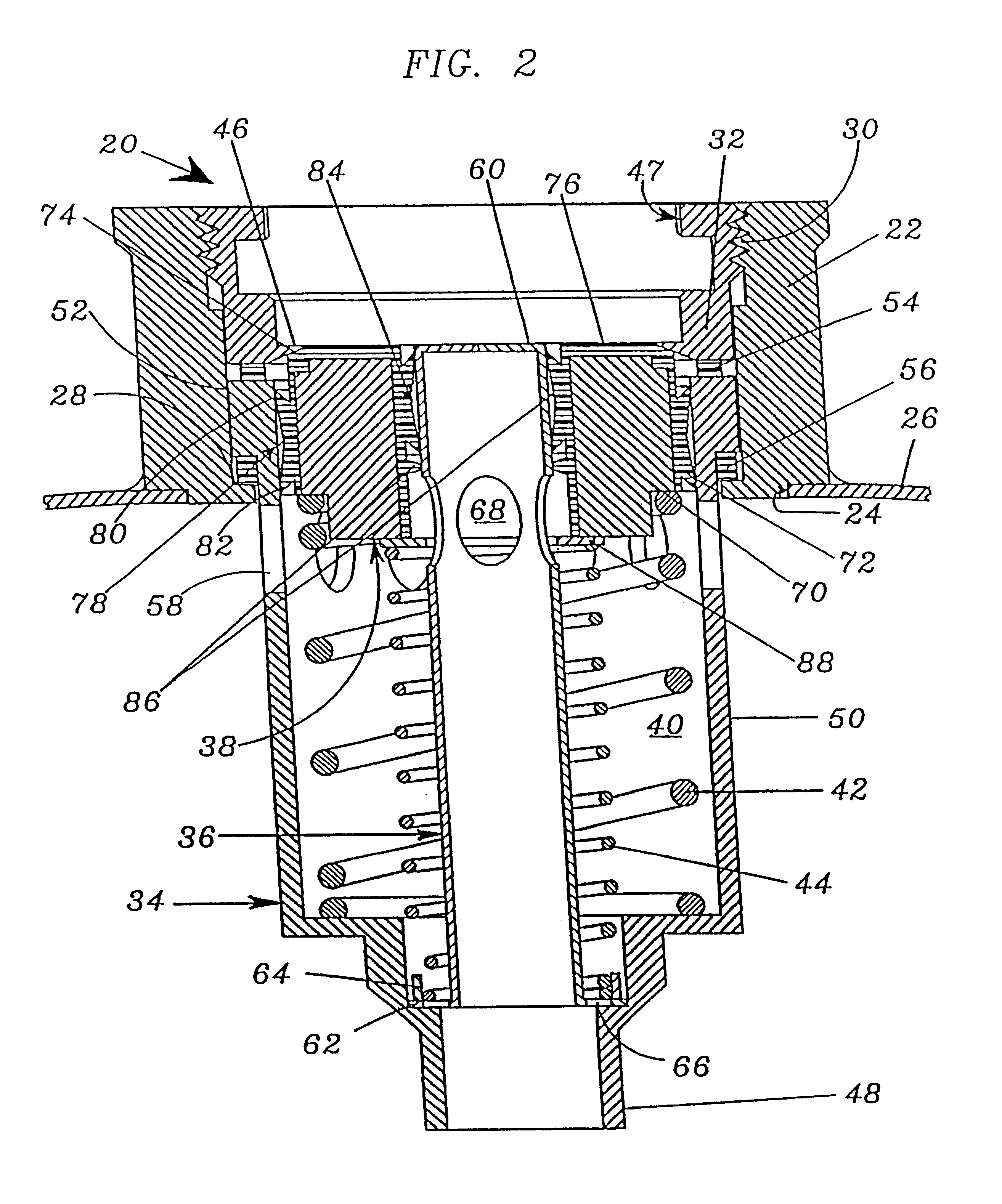Valve assembly for controlling fluid ingress and egress from a transportable container which stores and distributes liquid under pressure
a technology of valve assembly and container, which is applied in the direction of transportation and packaging, machines/engines, liquid transferring devices, etc., can solve the problems of valve components being out of the container opening at high speed, substantial risk to personnel and/or surroundings, and not solving other problems, so as to enhance the self-threading nature of the retainer assembly
- Summary
- Abstract
- Description
- Claims
- Application Information
AI Technical Summary
Benefits of technology
Problems solved by technology
Method used
Image
Examples
first embodiment
2. Description of First Embodiment
Turning now to the drawings and initially to FIGS. 1-4 in particular, the inventive valve assembly 20 is designed for connection to a standard stub 22 surrounding an aperture 24 in a container 26. Container 26 may comprise a barrel or any other transportable or stationary structure for storing beverages or other liquids and for dispensing the stored liquids under gas pressure. The stub 22 coaxially surrounds the aperture 24 in the container 26 and is fixed to the container 26, e.g., by welding. Stub 22 presents an internal radial shoulder 28 supporting the riser pipe or valve cup 34 as detailed below and also presents upper radial threads 30 for connection to a housing 32 of the valve assembly 20 also as detailed below.
Valve assembly 20 includes as its major components a housing 32 which also functions as a retainer for the remaining components of the valve assembly 20, a stationary riser pipe 34, a dispensing tower 36, and a sealing ring 38. An ann...
second embodiment
3. Description of Second Embodiment
Referring to FIGS. 5-8, components of the valve assembly 220 of the second embodiment corresponding to components of the valve assembly 20 of the first embodiment (illustrated in FIGS. 1-4) are designated by the same reference numerals, incremented by 200. The valve assembly 220 of FIGS. 5-8 differs from the valve assembly 20 of FIGS. 1-4 in that (1) the sealing ring 238 is of slightly different design, (2) one of the springs of the first embodiment has been eliminated, and (3) dispensing tower 236 has been redesigned to accommodate the elimination of one of the springs. These discrepancies from the first embodiment will now be detailed.
Sealing ring 238 is configured for sliding movement in the chamber 240 in the same manner as the sealing ring 38 of the first embodiment. However, this sealing ring 238, unlike the sealing ring 38 of the first embodiment, is formed of a single unitary polymer member and thus lacks the rigidifying insert of the first...
third embodiment
4. Description of Third Embodiment
Turning now to FIGS. 9-12, a valve assembly 320 constructed in accordance with a third embodiment of the invention is illustrated which is similar to the valve assembly 220 of the second embodiment. Components of the third embodiment corresponding to those of the second embodiment are, accordingly, designated by the same reference numerals, incremented by 100.
The valve assembly 320 of the third embodiment differs from the valve assembly 220 of the second embodiment primarily in that the dispensing tower 336 takes the form of an imperforate standpipe assembly rather than a perforated hollow pipe. The dispensing tower 336 therefore includes an upper head 361 of relatively large diameter and a lower shank 363 of relatively small diameter separated by a downwardly facing shoulder 369 on the head 361. An annular plate 362 is affixed to the bottom end portion of the shank 363 and serves the same function as the annular flange 262 of the second embodiment,...
PUM
 Login to View More
Login to View More Abstract
Description
Claims
Application Information
 Login to View More
Login to View More - R&D
- Intellectual Property
- Life Sciences
- Materials
- Tech Scout
- Unparalleled Data Quality
- Higher Quality Content
- 60% Fewer Hallucinations
Browse by: Latest US Patents, China's latest patents, Technical Efficacy Thesaurus, Application Domain, Technology Topic, Popular Technical Reports.
© 2025 PatSnap. All rights reserved.Legal|Privacy policy|Modern Slavery Act Transparency Statement|Sitemap|About US| Contact US: help@patsnap.com



